PARAPHRASING AS A METHOD OF AVOIDING PLAGIARISM
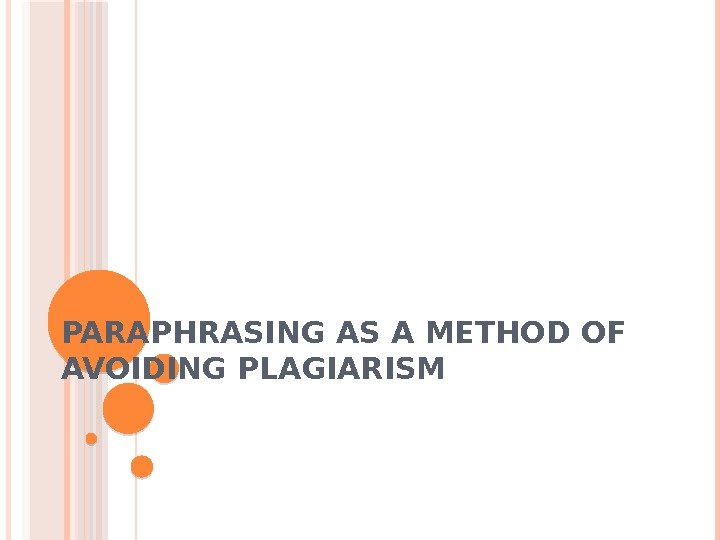
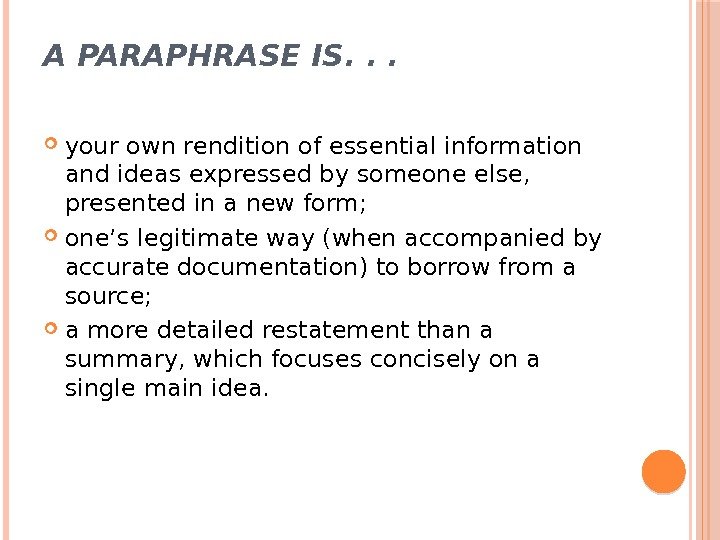
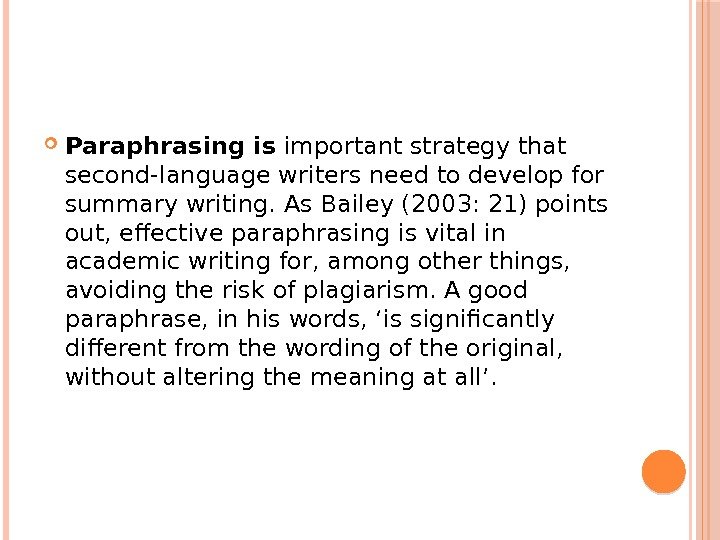
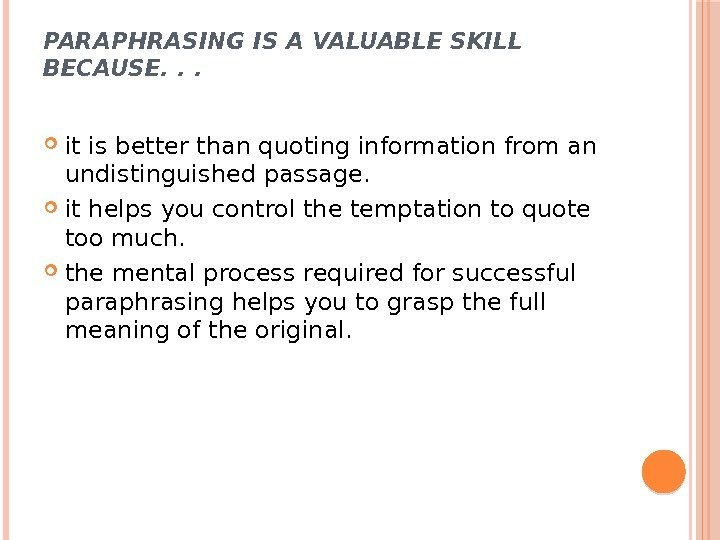
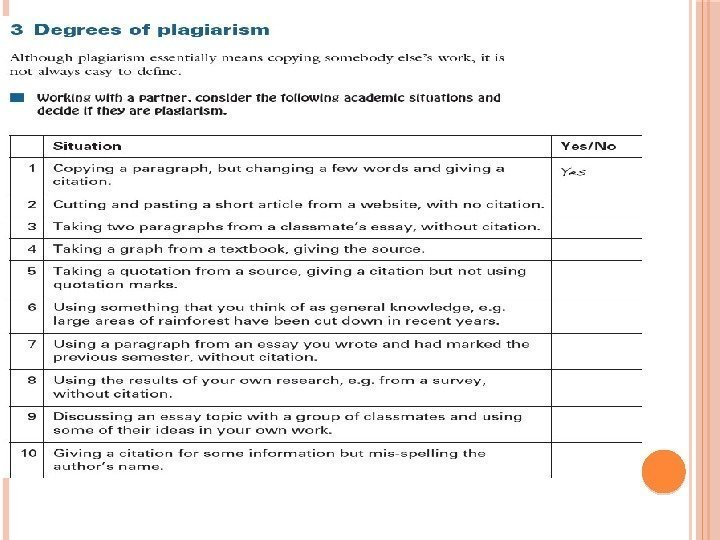
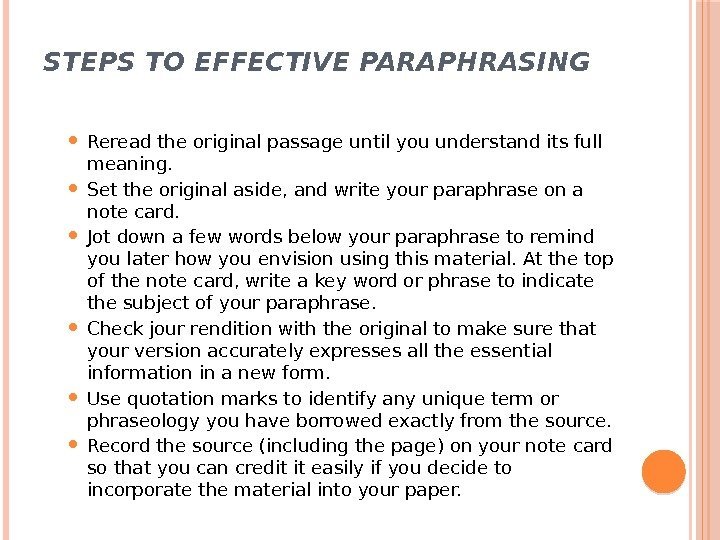
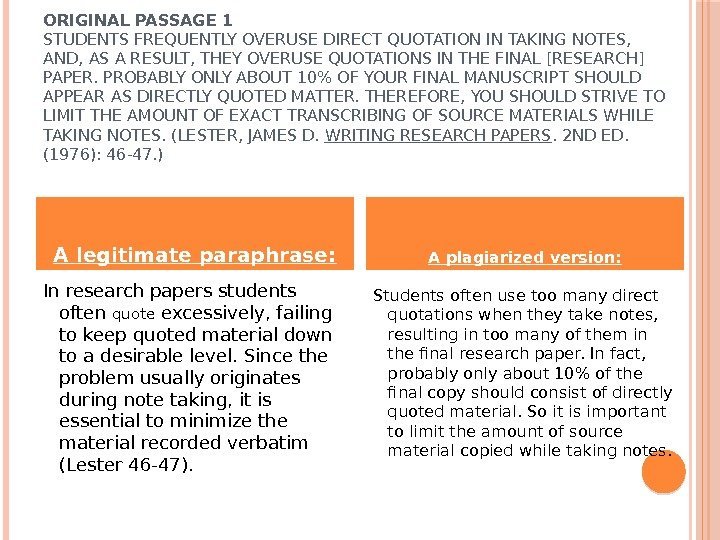
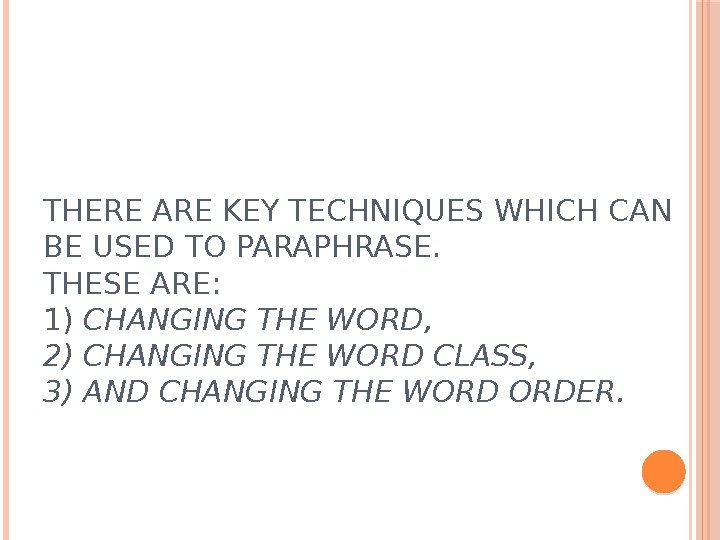
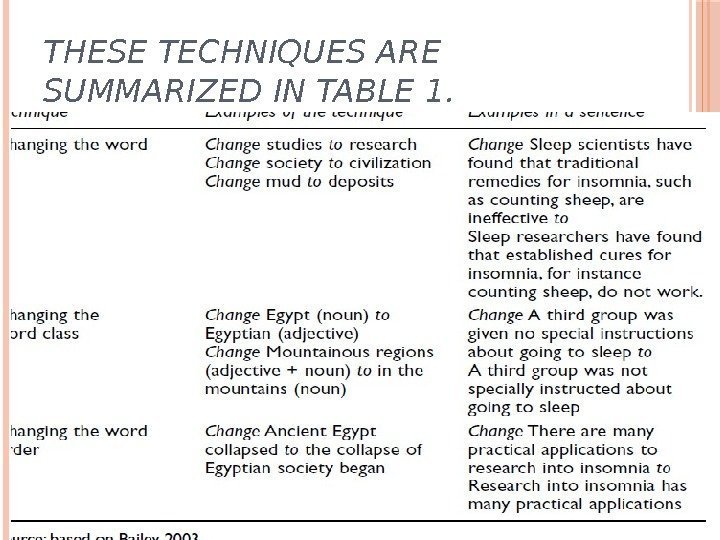
praktika_5_paraphrasing.pptx
- Размер: 607.4 Кб
- Автор:
- Количество слайдов: 9
Описание презентации PARAPHRASING AS A METHOD OF AVOIDING PLAGIARISM по слайдам
 PARAPHRASING AS A METHOD OF AVOIDING PLAGIARISM
PARAPHRASING AS A METHOD OF AVOIDING PLAGIARISM
 A PARAPHRASE IS. . . your own rendition of essential information and ideas expressed by someone else, presented in a new form; one’s legitimate way (when accompanied by accurate documentation) to borrow from a source; a more detailed restatement than a summary, which focuses concisely on a single main idea.
A PARAPHRASE IS. . . your own rendition of essential information and ideas expressed by someone else, presented in a new form; one’s legitimate way (when accompanied by accurate documentation) to borrow from a source; a more detailed restatement than a summary, which focuses concisely on a single main idea.
 Paraphrasing is important strategy that second-language writers need to develop for summary writing. As Bailey (2003: 21) points out, effective paraphrasing is vital in academic writing for, among other things, avoiding the risk of plagiarism. A good paraphrase, in his words, ‘is significantly different from the wording of the original, without altering the meaning at all’.
Paraphrasing is important strategy that second-language writers need to develop for summary writing. As Bailey (2003: 21) points out, effective paraphrasing is vital in academic writing for, among other things, avoiding the risk of plagiarism. A good paraphrase, in his words, ‘is significantly different from the wording of the original, without altering the meaning at all’.
 PARAPHRASING IS A VALUABLE SKILL BECAUSE. . . it is better than quoting information from an undistinguished passage. it helps you control the temptation to quote too much. the mental process required for successful paraphrasing helps you to grasp the full meaning of the original.
PARAPHRASING IS A VALUABLE SKILL BECAUSE. . . it is better than quoting information from an undistinguished passage. it helps you control the temptation to quote too much. the mental process required for successful paraphrasing helps you to grasp the full meaning of the original.

 STEPS TO EFFECTIVE PARAPHRASING Reread the original passage until you understand its full meaning. Set the original aside, and write your paraphrase on a note card. Jot down a few words below your paraphrase to remind you later how you envision using this material. At the top of the note card, write a key word or phrase to indicate the subject of your paraphrase. Check jour rendition with the original to make sure that your version accurately expresses all the essential information in a new form. Use quotation marks to identify any unique term or phraseology you have borrowed exactly from the source. Record the source (including the page) on your note card so that you can credit it easily if you decide to incorporate the material into your paper.
STEPS TO EFFECTIVE PARAPHRASING Reread the original passage until you understand its full meaning. Set the original aside, and write your paraphrase on a note card. Jot down a few words below your paraphrase to remind you later how you envision using this material. At the top of the note card, write a key word or phrase to indicate the subject of your paraphrase. Check jour rendition with the original to make sure that your version accurately expresses all the essential information in a new form. Use quotation marks to identify any unique term or phraseology you have borrowed exactly from the source. Record the source (including the page) on your note card so that you can credit it easily if you decide to incorporate the material into your paper.
 ORIGINAL PASSAGE 1 STUDENTS FREQUENTLY OVERUSE DIRECT QUOTATION IN TAKING NOTES, AND, AS A RESULT, THEY OVERUSE QUOTATIONS IN THE FINAL [RESEARCH] PAPER. PROBABLY ONLY ABOUT 10% OF YOUR FINAL MANUSCRIPT SHOULD APPEAR AS DIRECTLY QUOTED MATTER. THEREFORE, YOU SHOULD STRIVE TO LIMIT THE AMOUNT OF EXACT TRANSCRIBING OF SOURCE MATERIALS WHILE TAKING NOTES. (LESTER, JAMES D. WRITING RESEARCH PAPERS. 2 ND ED. (1976): 46 -47. ) In research papers students often quote excessively, failing to keep quoted material down to a desirable level. Since the problem usually originates during note taking, it is essential to minimize the material recorded verbatim (Lester 46 -47). Students often use too many direct quotations when they take notes, resulting in too many of them in the final research paper. In fact, probably only about 10% of the final copy should consist of directly quoted material. So it is important to limit the amount of source material copied while taking notes. A legitimate paraphrase: A plagiarized version:
ORIGINAL PASSAGE 1 STUDENTS FREQUENTLY OVERUSE DIRECT QUOTATION IN TAKING NOTES, AND, AS A RESULT, THEY OVERUSE QUOTATIONS IN THE FINAL [RESEARCH] PAPER. PROBABLY ONLY ABOUT 10% OF YOUR FINAL MANUSCRIPT SHOULD APPEAR AS DIRECTLY QUOTED MATTER. THEREFORE, YOU SHOULD STRIVE TO LIMIT THE AMOUNT OF EXACT TRANSCRIBING OF SOURCE MATERIALS WHILE TAKING NOTES. (LESTER, JAMES D. WRITING RESEARCH PAPERS. 2 ND ED. (1976): 46 -47. ) In research papers students often quote excessively, failing to keep quoted material down to a desirable level. Since the problem usually originates during note taking, it is essential to minimize the material recorded verbatim (Lester 46 -47). Students often use too many direct quotations when they take notes, resulting in too many of them in the final research paper. In fact, probably only about 10% of the final copy should consist of directly quoted material. So it is important to limit the amount of source material copied while taking notes. A legitimate paraphrase: A plagiarized version:
 THERE ARE KEY TECHNIQUES WHICH CAN BE USED TO PARAPHRASE. THESE ARE: 1) CHANGING THE WORD, 2) CHANGING THE WORD CLASS, 3) AND CHANGING THE WORD ORDER.
THERE ARE KEY TECHNIQUES WHICH CAN BE USED TO PARAPHRASE. THESE ARE: 1) CHANGING THE WORD, 2) CHANGING THE WORD CLASS, 3) AND CHANGING THE WORD ORDER.
 THESE TECHNIQUES ARE SUMMARIZED IN TABLE 1.
THESE TECHNIQUES ARE SUMMARIZED IN TABLE 1.
